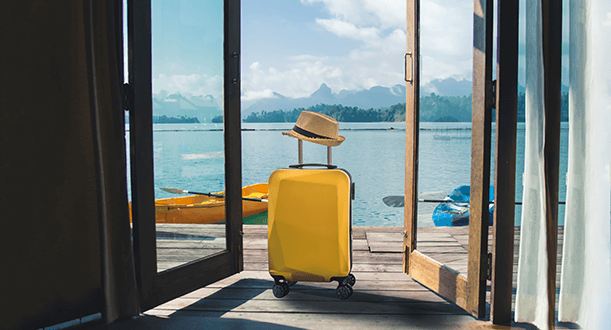June 21, 2021
Traveling on the Protocol

By Julie Gregory, Chief Health Liaison for Apollo Health
With the pandemic slowly on the wane and the vaccination rate increasing, the idea of travel once again feels within reach. Many of us have been struck with wanderlust but might have second thoughts about taking the protocol on the road. It’s absolutely possible with some careful planning and reframing of expectations. Keep in mind that travel restrictions (proof of vaccination, COVID testing, or a quarantine period) may still be in effect in some areas. Click here to find the Centers for Disease Control and Prevention’s latest travel tips for traveling domestic or internationally so that you know what to expect.
Reframe expectations Pre-protocol; you may have thought of taking a vacation as an opportunity to “see everything” and “do everything” while concurrently eating and drinking with wild abandon — a whirlwind of activity that may have left you feeling exhausted, overweight, and hungover. Instead, we invite you to reframe your get-away as an opportunity to continue to apply the protocol by pampering yourself. Create your own spa-like experience wherever you go. By optimally caring for yourself, you’ll continue to promote healing and be fully present to soak in the novelty of exploring and luxuriating in a different environment.
Diet One of the most challenging aspects of travel is finding the same quality food that you’re used to enjoying on the protocol. After experiencing the benefits of KetoFLEX 12/3, many people are concerned that they will be forced to go off the diet when away from home. You can get around that by planning to prepare some (or most) of your own food while on the road by booking accommodations that allow you to cook. More and more hotel chains offer larger home-like suites that include fully stocked mini-kitchens, and booking sites like Airbnb and Vrbo offer rentals with full kitchens. Create an adventure by exploring your new locale to source healthy ingredients that incorporate some of the local flavor. Whether you do some of your own cooking or decide to enjoy dining out, see our tips for navigating the restaurant experience.
● Look for “Farm to Table” restaurants. Because more and more people are becoming aware of the health benefits of carefully sourcing their food, restaurants are popping up that cater to this demand. These eateries typically source local, organic, and seasonal vegetables along with wild-caught seafood and grass-fed meats. They can end up being a bit pricier, but the assurance that you’re still eating the quality food to which you’ve become accustomed.
● Vegetarian or vegan restaurants are another great option. This doesn’t mean that you can eat anything off the menu (grains, white potatoes, pasta, etc.), but it does increase the chances that you’ll be able to find large quantities of healthful vegetables. Sadly, many traditional restaurants consider three asparagus spears to constitute a serving of vegetables. When that’s what you’re primarily eating, it gets surprisingly tricky to find food. A vegetarian or vegan restaurant typically provides larger servings of (often organic) vegetables.may be worth the splurge. It’s a terrific option, especially while traveling.
● Salads can be a great starting place. Choose a mix of fresh greens and other healthful vegetables. Avocados, olives, nuts, and seeds are always good as they’re high in brain-healthy fats and quite filling. Be on the lookout for unhealthy add-ons, like croutons, tortilla strips, candied nuts, or dried fruit coated with sugar. Carefully consider if you want to add a protein if you’re at a traditional restaurant. Unless otherwise advertised, the poultry and meat will come from concentrated animal feeding operations (CAFOs), and the seafood is typically farmed. Never order the dressing. It’s typically full of sugar and unhealthy fats. Instead, bring your own high polyphenol EVOO that you can tuck into a purse or messenger bag. Specialty Bottle sells small quantities of 2 and 4 oz. amber glass bottles. We prefer the colored glass to protect the oil from oxidation, but clear is fine as long as you store it away from any light. Two ounces is a perfect size for one person/one salad on the KetoFLEX 12/3 plan. Many couples share a 4 oz.sized bottle. Be sure to place it in a sealed plastic bag so as not to ruin the lining of your carrier.
● Bring your own protein. If you know the restaurant you’ll be eating at only serves unhealthy animal protein, bring your own pre-cooked piece of salmon (consider Wild Planet’s Wild Sockeye Salmon), pastured boiled eggs, or hemp hearts in a small portable container that you tuck into your purse or messenger bag. You can order a large serving of cooked vegetables or a salad as the perfect accompaniment and create your own healthful meal by adding your own protein.
● Forget the menu. This doesn’t always work, but it’s certainly worth a try. If you peruse the menu and don’t see an option that will work, tell the waitstaff that you have specific dietary requirements and eat primarily vegetables. They’re often happy to create an original dish to your specifications such as a plate of steamed veggies (that you can season with your own EVOO) or an omelet loaded with vegetables in exchange for the potatoes and toast. You can always call ahead and try to gauge their flexibility.
Exercise Travel is a wonderful opportunity to explore the local area — and there’s no better way to do it than by foot. Try to book accommodations that are relatively close to the areas that you hope to explore, and be sure to bring comfortable walking shoes. Plan to soak in your new locale by taking long rambling daily walks. Browse local attractions, shops, cafes, parks, trails, or beaches. Consider engaging in other exercise opportunities that also enable you to see the local sights through the rental of bicycles, kayaks, or snorkeling gear.
Sleep Make restorative quality sleep (especially if crossing time zones) an important centerpiece of your vacation. Practice the same sleep hygiene that you do when at home. Wind-down before bed; dim the lights, use blue-blocking glasses, cool the room, and consider a long soak in a warm bath. If melatonin isn’t a part of your evening supplement routine, consider adding it during travel to help with adapting to a new time zone and environment. If you have sleep apnea and use a CPAP, be sure to bring it along or consider buying a smaller travel-size unit; your brain always needs oxygen. By prioritizing sleep, you’ll be more likely to stick to the protocol and truly able to soak in the novelty of seeing and exploring a different environment. Also, refrain from cramming your days full of activities. Allow room for an afternoon nap or meditation session.
Brain Stimulation If you enjoy brain training, crosswords, sudoku puzzles, or other challenges, by all means, continue to practice while on vacation. All are wonderful ways of occupying yourself while traveling to or from your destination. On the other hand, if you perceive these challenges to be a chore, feel free to skip while on vacation. The experience of travel, meeting new people, socializing, and exploring a new area is an excellent form of brain stimulation unto itself.
Supplements Traveling with supplements can be a challenge! We’ve all struggled to try to find room in our suitcase for sizable supplement containers and searched high and low to find pill organizers big enough to accommodate large quantities of supplements only to find they popped open during travel, and your supplements are sprinkled everywhere- ugh. There’s good news for those using LifeSeasons supplements. They’ll soon be offering travel-friendly new packaging that pre-portions the morning and evening powders into sealed paper straws like “Pixie Stix” candy. The additional supplements (including the multivitamin, Omega-3, probiotics, and specific sub-type formulas, etc.) in their line will be packaged into convenient portable pill packs.
Those using individual supplements may wish to consider making their own prepackaged powders or pill packs, labeled as AM or PM, with either small snack-sized baggies or (for those trying to avoid the toxins in plastics) with reusable canvas drawstring bags like those found here. Be aware that any powders in containers or small bags may be subject to TSA inspection for explosive potential. For that reason, it may be easier to check your bag. The strategies outlined here are TSA compliant, but some states require that you keep medications in their original prescription bottle. Reach out to the TSA with any question 72 hours prior to travel: TSA-ContactCenter@tsa.dhs.gov.
Everyone jokes about need a vacation from a vacation. By practicing these tips and adhering to the protocol, you can make this a different kind of holiday, where you return home rested, rejuvenated, and more resilient than ever. Safe and happy travels to all. Make memories to last a lifetime!




